|
Have a safe day!
Thursday, June 10
2:30 p.m.
Theoretical Physics Seminar - Curia II
Speaker: Wouter Waalewijn, Massachusetts Institute of Technology
Title: Factorization at the Tevatron and LHC: From PDFs to Initial State Jets
3:30 p.m.
DIRECTOR'S COFFEE BREAK - 2nd Flr X-Over
4 p.m.
Accelerator Physics and Technology Seminar - One West
Speaker: Tiago Silva, University of Sao Paolo
Title: Beam Monitoring Using Optical Transition Radiation
Friday, June 11
3:30 p.m.
DIRECTOR'S COFFEE BREAK - 2nd Flr X-Over
4 p.m.
Joint Experimental-Theoretical Physics Seminar - One West
Speaker: Gavril Giurgiu, Johns Hopkins University
Title: Measurement of CP Violation in Bs → J/ Ψφ Decays at CDF
Click here for NALCAL,
a weekly calendar with links to additional information.
Upcoming conferences |
|
For information about H1N1, visit Fermilab's flu information site.
|
|
Thursday, June 10
- Breakfast: Apple sticks
- Tomato Florentine
- BBQ pork sandwich
- Kielbasa & sauerkraut
- Chicken Marsala
- Smoked turkey melt
- Assorted sliced pizza
- SW chicken salad w/roasted corn salsa
Wilson Hall Cafe Menu
|
|
Thursday, June 10
Dinner
- Closed
Wednesday, June 16
Lunch
- Spicy sausage & cheese stuffed portobello mushroom
- Baby greens w/mango & marinated onions
- Fruit tart
Chez Leon Menu
Call x3524 to make your reservation.
|
|
|
Fermilab looks to lead the dark side
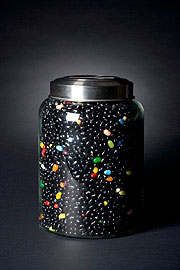 |
| This jar of jelly beans, often referred to as the jelly bean universe, displays the percentages of dark matter and visible matter. Colored jelly beans represent the visible matter in the universe. |
Theorists predict recent and ongoing advances in a range of technologies targeting dark matter will shine a light on its origin within the next five to 10 years. What experiment will serve as that flashlight? Will it shine from underground from an accelerator or through a telescope lens?
Experiments across the globe are vying to claim the prize by creating unique and larger detectors and Cristiano Galbiati, of Princeton University, said Fermilab likely will play a role.
"Right now, in my opinion, nothing comes closer to being a dark matter lab than Fermilab," he said during a talk at last week's Fermilab Users' Meeting.
The laboratory works through the Tevatron at Fermilab and CMS at the LHC to produce dark matter and through the Sloan Digital Sky Survey and upcoming Dark Energy Survey to measure its effects on a cosmic scale. But R&D projects with several universities for second-generation direct searches via nuclear recoils in the CDMS, COUPP and DarkSide experiments position the laboratory as a pioneer.
This is a push by the U.S. dark-matter community to take the lead in building bigger detectors, which can reduce background interference, using complementary technology: liquid argon, Xenon and CFI. Laboratories in Italy, Canada and Minnesota in the U.S. do, or will house, these small and medium detectors. Plans for deployment of the largest versions coincide with the 2017 to 2019 potential construction timeline of the proposed U.S. Deep Underground Science and Engineering Laboratory.
-- Tona Kunz
|
New employees - June 1
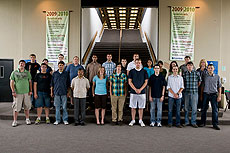 |
| Front row from left: Brett Zimmerman, Travis Roon, Virag Nanavati, Venktesh Singh, Kaitlyn Sprosty, Danny Smith, Michael Szuba, William Ponstein, Kyle Beczkiewicz, Daniel Brandt and Mathew Muether. Second row from left: Kevin Crampton, Lindsey Whiting, Kenny Gould, Ryan Mahoney, Azeam Anjum, Drew Sobczak, Matthew Michelotti, Tom Barnett, Falguni Soni, Leah Hesla, Bethany Herwaldt, Joshua Heidorn and Cindy Fuhrer.
|
|
Enjoy Fermilab Family Outdoor Fair on June 13
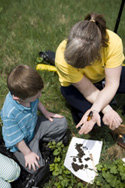 |
| Children can learn about nature at Fermilab's Family Outdoor Fair this weekend. |
Enjoy a day of bison, birds and bugs while learning about science and fun things to do outside this summer at Fermilab's annual Family Outdoor Fair.
Families and scout troops can drop by anytime between 1 and 4 p.m. Sunday, June 13, to explore a dozen hands-on activities that highlight the plant and animal life found at the Batavia physics laboratory.
The three-year-old program grew out of the Leave No Child Inside initiative aimed at keeping children active and learning during the summer. Children can learn about history from speakers dressed in 19th century settler attire, geology through a large fossil collection, ecology through prairie tours and soil core samples and biology through animal examinations.
"Science doesn't have to just happen in a lab," said co-organizer Gail Poisson, Fermilab docent. "We want to show parents and their children that science is everywhere."
Children can make animal print tracks, net pond critters, take a nature scavenger hunt on a trail through the prairie and dig through decaying logs for insects. They can view the laboratory's bison herd, hear about its history and use a stop watch to see if they can run faster than these 1,500-pound beasts.
Read more
|
Testing targets for producing steady neutrino beams
From DOE Pulse, June 7, 2010
While neutrinos are among the most abundant particles in the universe, they rarely interact with other matter. They are often described as "ghost" particles and, in many ways, they are just as mysterious.
Neutrinos are created through nuclear reactions such as those powering the sun and other stars but much about them is still unknown. For the past several months, scientists at Brookhaven National Laboratory (BNL) on Long Island have been conducting experiments on potential materials for producing neutrino beams artificially here on Earth as part of the Long Baseline Neutrino Experiment (LBNE), a project funded by the Department of Energy's Office of Science. The plan is for the world's highest-intensity neutrino beam to be produced at Fermi National Accelerator Laboratory (Fermilab) and sent more than 1,000 kilometers through the Earth to detectors at the proposed Deep Underground Science and Engineering Laboratory (DUSEL) in South Dakota. From measurements at these detectors, scientists hope to learn more about the three known types of neutrinos and how they oscillate, or change, from one type to another.
Read more
|
|
|
A tale of two bosons
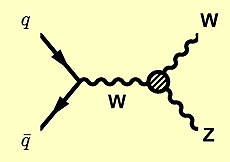 |
| The emission of a Z boson by a W boson is an interesting process in which to search for new physics. The shaded circle here indicates what DZero scientists are studying. |
The W and Z boson were both discovered at CERN in the early 1980s, cementing the then-new electroweak theory as an explanation for how the weak and electromagnetic forces are two sides of a single coin. The realization that these two seemingly different forces were the same was a real triumph of the theoretical physics worked out over the preceding two decades.
During the following 30 years, physicists have studied these bosons both in the LEP accelerator at CERN and here at the Tevatron. Physicists now know the properties of these particles very precisely.
However, simultaneous production of the W and Z boson has not been well studied. To give a sense of scale, the analysis discussed here resulted in a mere 34 events, even when using the largest single data set in history. We can contrast this with the millions of W and Z bosons produced individually.
With so few collisions in which both bosons were created, it is not surprising that there remains keen interest in this particular process. This interest is compounded by the fact that many proposed theoretical models suggest that it is in events like these that we might expect to see evidence for new physical phenomena.
The DZero experiment has studied these data carefully and sees no evidence for anything beyond what the Standard Model predicts. When no unexpected events are observed, we can use statistical techniques to set limits on any new theories. While not as satisfying as a discovery, knowing what is not true is just as important for the advancement of science. The analysis described in this recent paper has set the most stringent limits on new physics using this particular particle production channel.
-- Don Lincoln
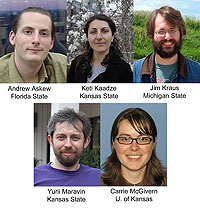 |
| These analyzers were involved in this analysis. |
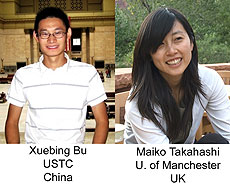 |
| This analysis depends on properly identifying electrons in our detector. These physicists are leaders of the algorithm group responsible for identifying electrons and photons. |
|
|